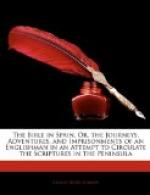I raised my eyes in the direction in which he pointed. Half way up the mountain, over whose foot we were wending, jutted forth a black frightful crag, which at an immense altitude overhung the road, and seemed to threaten destruction. It resembled one of those ledges of the rocky mountains in the picture of the Deluge, up to which the terrified fugitives have scrambled from the eager pursuit of the savage and tremendous billows, and from whence they gaze down in horror, whilst above them rise still higher and giddier heights, to which they seem unable to climb. Built on the very edge of this crag, stood an edifice, seemingly devoted to the purposes of religion, as I could discern the spire of a church rearing itself high over wall and roof. “That is the house of the Virgin of the Rocks,” said the peasant, “and it was lately full of friars, but they have been thrust out, and the only inmates now are owls and ravens.” I replied, that their life in such a bleak exposed abode could not have been very enviable, as in winter they must have incurred great risk of perishing with cold. “By no means,” said he; “they had the best of wood for their braseros and chimneys, and the best of wine to warm them at their meals, which were not the most sparing. Moreover, they had another convent down in the vale yonder, to which they could retire at their pleasure.” On my asking him the reason of his antipathy to the friars, he replied, that he had been their vassal, and that they had deprived him every year of the flower of what he possessed. Discoursing in this manner, we reached a village just below the convent, where he left me, having first pointed out to me a house of stone, with an image over the door, which, he said, once also belonged to the canalla (rabble) above.




